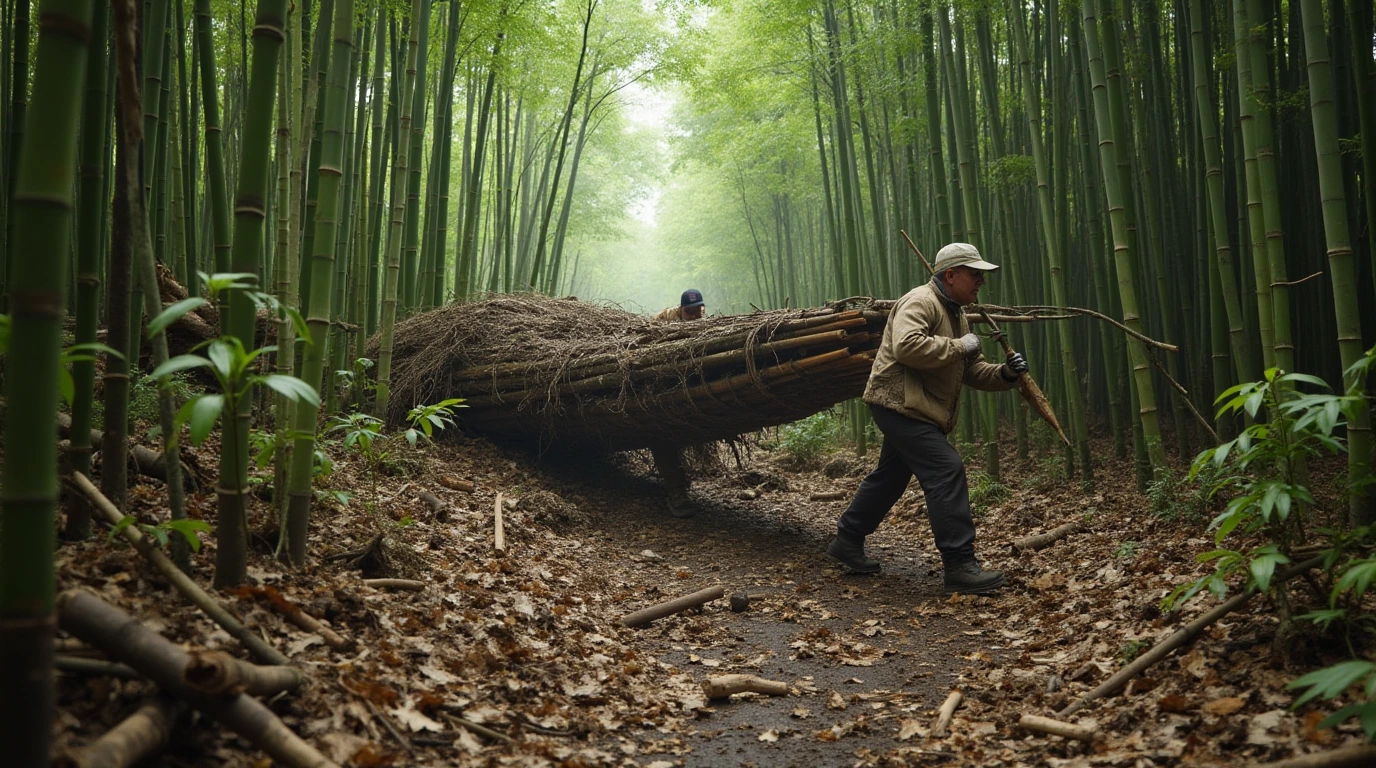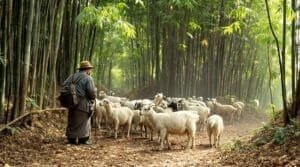Illegal logging poses a serious threat to the delicate ecosystems that red pandas call home. Found mainly in the temperate forests of the eastern Himalayas and southwestern China, red pandas rely on dense bamboo understories for food and survival. But as illegal timber operations expand across these regions, the consequences for red pandas are growing rapidly. From severe habitat loss and fragmentation to increased poaching access, the effects are far-reaching and deeply concerning
This article will explore how illegal logging affects red panda habitats by examining the degradation of bamboo forests, disruption of movement and breeding patterns, and the growing role of conservation efforts and community involvement. You’ll also learn about the regions most affected, the decline in red panda populations, and how illegal activities on the ground are shaping the future of this endangered species
Effects of Illegal Logging on Red Panda Habitats

Red pandas depend on highly specialized habitats located in the temperate forests of the eastern Himalayas, which span parts of Nepal, India, Bhutan, northern Myanmar, and southwestern China. These ecosystems, dominated by broadleaf and coniferous trees with dense bamboo understories, offer the shelter and sustenance red pandas require
However, illegal logging has increasingly encroached on these areas, with far-reaching consequences for both the animals and the ecosystems they inhabit. The destruction and degradation caused by illicit timber harvesting threaten not only the food sources and shelter availability but also the long-term survival of fragmented red panda populations
Deforestation and Its Impact on Bamboo Availability
One of the most immediate consequences of illegal logging in red panda habitats is the destruction of bamboo, which comprises about 95% of their diet. Red pandas consume several bamboo species, including Yushania and Arundinaria, both of which are highly sensitive to ecological disturbances. When forests are illegally logged, these bamboo species are either removed directly or suffer from changes in soil composition and sunlight exposure, making regrowth challenging
The Red Panda Network highlights that illegal logging often occurs in community-managed forests, particularly in Nepal’s Panchthar–Ilam–Taplejung (PIT) corridor. These forests, while not officially protected, are essential to maintaining biodiversity and providing food sources for the red pandas. Logging reduces bamboo abundance, and because bamboo flowers infrequently and then dies off in cycles, the recovery of a decimated bamboo stand can take years
Moreover, studies like those published by the International Union for Conservation of Nature (IUCN) in their Red Panda Action Plan (2015–2025) emphasize the correlation between bamboo loss and declining red panda activity in affected areas. A 2019 habitat suitability analysis conducted by the Kathmandu Forestry College also demonstrated that bamboo density directly correlates with red panda presence, making the preservation of this vegetation absolutely necessary for their survival
Habitat Fragmentation and Population Isolation
Illegal logging doesn’t just strip the land—it fragments what remains. Logging often involves the construction of temporary roads, which divide previously continuous tracts of red panda habitat. This fragmentation isolates individuals and groups, creating “islands” of suitable habitat within a matrix of degraded land, roads, and human encroachment
This isolation has severe implications for red panda populations. Genetic studies, such as those presented by Hu et al. (2020) in the Science Advances journal, have shown that fragmented habitats lead to lower genetic diversity due to inbreeding and limited mate selection. Movement between habitat patches becomes riskier and more energy-intensive, especially in areas with frequent human activity
The Red Panda Network’s field research found that red pandas in fragmented areas tend to have smaller home ranges and are less likely to reproduce successfully. Additionally, these animals often suffer higher stress levels, indicated by hormone studies using fecal samples, due to constant exposure to nearby human activity—be it logging, herding, or settlement expansion
Logging Roads and Increased Poaching Risks
Perhaps one of the most under-recognized threats that stems from illegal logging is the unintended facilitation of poaching through the expansion of access routes. Temporary and unregulated logging roads allow poachers to penetrate previously inaccessible forest areas. These access points make it easier to capture red pandas for their fur or for sale in the illegal pet trade
According to data published by Earth.Org, illegal roads have led to spikes in red panda trafficking, particularly in northeastern India and Myanmar. Between 2010 and 2020, seizures of live red pandas and their body parts increased in areas newly accessible by logging infrastructure
The 2014 Mongabay article on conservation in Myanmar’s Northern Forest Complex further emphasizes how road-building for illegal timber extraction exacerbates the threats faced by red pandas. The region experienced a 7.9% forest cover loss between 2001 and 2012, and much of that is linked to human access facilitated by logging. Conservationists there have pointed to new roads as one of the primary drivers behind a rise in poaching activities
To explore how community-led conservation is addressing these challenges, the Red Panda Network offers an insightful overview of their local forest guardian programs and sustainable forestry initiatives that are helping combat illegal logging and poaching in key red panda territories. These locally managed interventions not only provide alternative livelihoods for communities dependent on forest resources but also significantly reduce pressure on red panda habitats by promoting habitat protection and sustainable practices
Regional and Population Impacts on Red Pandas

Red pandas occupy a narrow ecological niche, and their distribution is already limited to specific elevations (7,200 to 13,800 feet) within forest belts of the Himalayas and adjacent regions. Illegal logging, which often targets the mid-elevation forests rich in marketable timber, overlaps significantly with the red panda’s habitat range
The destruction of these forests is not uniformly distributed, and certain regions have become epicenters of habitat degradation. These geographical patterns of deforestation are directly tied to the species’ localized population declines and diminishing genetic diversity
Areas Most Affected by Illegal Logging
Among the most severely affected regions is eastern Nepal’s Panchthar–Ilam–Taplejung (PIT) corridor. This critical habitat zone connects several forest patches outside formal protected areas and is home to about 25% of Nepal’s red panda population. However, over 70% of red panda habitats here lie in community forests, where oversight is less stringent. The Red Panda Network has documented extensive illegal timber harvesting in this corridor, especially in areas where road infrastructure is under development, making once-remote forests accessible
In India, the state of Arunachal Pradesh has also been identified as a hotspot. According to a 2021 study published in the Movement Ecology Journal, satellite imagery showed high rates of forest loss in the Tawang and West Siang districts. These forests serve as a natural corridor for red panda movement into Bhutan and southeastern Tibet, meaning that logging here disrupts broader regional connectivity for the species
Myanmar’s northern forests, particularly those in Kachin State within the Northern Forest Complex, have seen increasing logging activity over the past two decades. As highlighted in a report by Mongabay, this region lost nearly 8% of its forest cover between 2001 and 2012, much of it due to illegal felling operations that supply both domestic and cross-border timber markets
Southwestern China, especially in Yunnan and Sichuan provinces, has also experienced habitat degradation. Although government logging bans have curbed official operations since the early 2000s, illegal logging persists in remote mountain zones. These areas are home to a distinct subspecies of the red panda (Ailurus styani), which is now considered even more vulnerable due to its limited and fragmented range
Documented Population Declines in Red Panda Zones
The red panda is classified as “Endangered” by the IUCN, with an estimated global population of fewer than 10,000 mature individuals. Over the last two decades, studies have documented a decline of nearly 50% in some localized populations. These reductions are most strongly correlated with regions undergoing rapid deforestation, especially from unregulated timber extraction
A long-term study published in Ecology and Evolution (2020) monitored red panda populations in the PIT corridor and found a significant drop in both sightings and camera trap detections in areas adjacent to known illegal logging routes. These patterns align with a 2015–2020 Red Panda Network monitoring report, which concluded that active logging zones saw red panda activity drop by 35% over just five years
In China, research conducted by Hu et al. (2023) and published in Nature Ecology & Evolution used environmental DNA (eDNA) sampling across fragmented landscapes in Sichuan. The findings showed lower population density and reduced genetic diversity in logged areas, further supporting the link between habitat degradation and red panda decline
Moreover, the fragmentation caused by illegal logging not only reduces the available area but also increases the edge effect—exposing red pandas to predators and human interactions. These edge zones, which border deforested clearings, are associated with higher mortality rates due to poaching, dog attacks, and accidents
A deeper look into how these patterns intersect with human development and forest policy can be found in this Mongabay article on Myanmar’s red panda conservation, which explores land-use pressures and efforts to mitigate biodiversity loss in one of the region’s last remaining forest strongholds
Conservation and Community Involvement

Efforts to combat illegal logging and protect red panda habitats rely heavily on both top-down conservation policies and grassroots engagement. While government agencies and international organizations implement broad-scale protective measures, it is often the work of local communities that forms the frontline of defense against habitat degradation
These joint conservation efforts have proven especially effective in red panda range countries like Nepal, Myanmar, and India, where community forestry, education, and habitat monitoring initiatives are directly addressing the threats of illegal logging
Protection Measures Against Illegal Logging
Governments in red panda range countries have taken steps to mitigate the impact of illegal logging through the establishment of protected areas and the enforcement of forestry laws. In Nepal, this includes the formation of protected corridors and community forests where red panda populations are known to thrive. One of the most notable initiatives is the Red Panda Community Forest program, managed by the Red Panda Network, which links fragmented forest patches to restore habitat connectivity while actively monitoring illegal logging activities
Similarly, in Myanmar, the establishment of Imawbum National Park in 2022 marked a significant leap in regional conservation. Covering over 150,000 acres in Kachin State, this park provides a sanctuary for red pandas and restricts commercial logging and land conversion. This development was supported by Fauna & Flora International and other NGOs, and it was shaped in consultation with local Lisu communities
China has imposed a national ban on commercial logging in natural forests since 2017. While enforcement remains a challenge in remote mountain areas, this policy has helped slow deforestation in parts of Sichuan and Yunnan, which are home to the red panda subspecies Ailurus styani. Local governments have also introduced forest monitoring using satellite data and drones to track illegal timber activity more efficiently
International support has also come in the form of funding and technical assistance from organizations such as the World Wildlife Fund (WWF), which runs anti-poaching units and ecosystem restoration programs. According to WWF reports, over 1.4 million acres of red panda habitat have been placed under protection through landscape-level conservation agreements in Nepal and India
For a comprehensive breakdown of these and related efforts, Earth.Org offers in-depth insights into red panda conservation, focusing on illegal logging impacts and the steps being taken to protect the species
Role of Local Communities in Forest Preservation
Perhaps the most transformative conservation work comes not from policies, but from the people who share the land with red pandas. In Nepal and India, community forest user groups (CFUGs) have become a model for participatory conservation. These groups are authorized to manage local forests under national law, and many have partnered with organizations like the Red Panda Network to integrate red panda conservation into forest management plans
One standout initiative is the Forest Guardian program, in which local residents are trained in biodiversity monitoring, anti-poaching surveillance, and habitat assessment. These guardians, often from indigenous or rural backgrounds, patrol forests, report illegal activities, and educate fellow villagers about sustainable resource use
In Myanmar, community involvement in red panda conservation is gaining momentum, particularly around Imawbum National Park. Here, local Lisu communities are co-managing conservation zones and developing eco-tourism and agroforestry as sustainable alternatives to logging. These efforts not only safeguard red panda habitats but also create economic incentives that reduce dependence on timber extraction
Education also plays a critical role. Programs aimed at schoolchildren and youth groups have fostered a new generation of conservation advocates. Red Panda Network’s education outreach has reached over 20,000 individuals in Nepal alone, contributing to a broader culture of environmental stewardship
While challenges remain, especially in enforcing protections and sustaining funding, the increasing collaboration between conservationists, local people, and governments offers a promising path forward. These community-driven strategies are turning the tide against illegal logging and creating more resilient ecosystems for red pandas and other forest species












